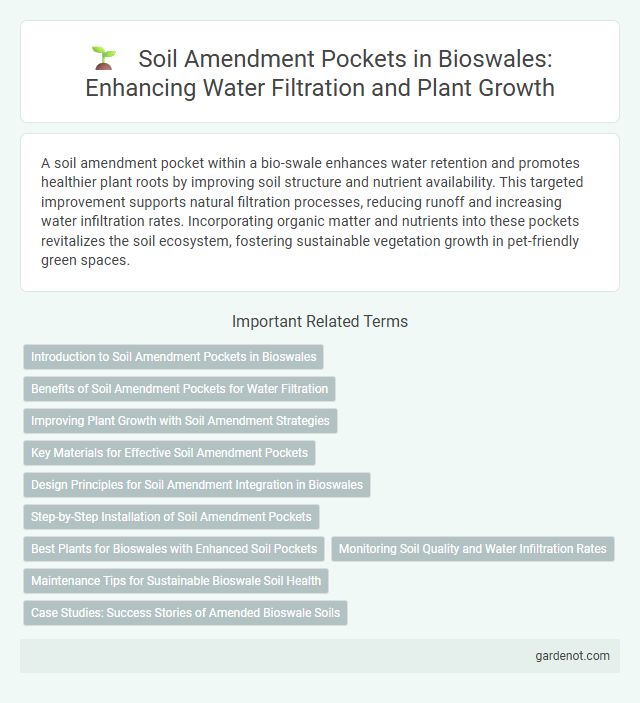A soil amendment pocket within a bio-swale enhances water retention and promotes healthier plant roots by improving soil structure and nutrient availability. This targeted improvement supports natural filtration processes, reducing runoff and increasing water infiltration rates. Incorporating organic matter and nutrients into these pockets revitalizes the soil ecosystem, fostering sustainable vegetation growth in pet-friendly green spaces.
Introduction to Soil Amendment Pockets in Bioswales
Soil amendment pockets in bioswales enhance soil structure and fertility by localizing organic matter and nutrient-rich materials directly where water infiltration occurs. These pockets improve microbial activity and root growth, promoting efficient stormwater absorption and pollutant filtration. Integrating soil amendments within bioswales optimizes soil moisture retention and supports the long-term health of planted vegetation.
Benefits of Soil Amendment Pockets for Water Filtration
Soil amendment pockets enhance water filtration by improving soil structure, increasing porosity, and boosting microbial activity, which accelerates pollutant breakdown. These pockets contain organic materials that retain moisture and nutrients, facilitating efficient infiltration and reducing runoff. Enhanced water retention and filtration in soil amendment pockets promote cleaner groundwater recharge and support healthier ecosystems.
Improving Plant Growth with Soil Amendment Strategies
Soil amendment pockets enhance bio-swale effectiveness by concentrating organic matter and nutrients directly at the root zone, promoting optimal plant growth. Incorporating compost, biochar, or peat moss improves soil structure, water retention, and microbial activity, leading to healthier vegetation and increased pollutant absorption. Targeted soil amendments also mitigate compaction and nutrient deficiencies, resulting in resilient plants that support sustainable stormwater management.
Key Materials for Effective Soil Amendment Pockets
Key materials for effective soil amendment pockets include compost, biochar, and well-graded sand, which enhance soil structure, nutrient retention, and water infiltration. Incorporating organic matter such as aged mulch and mycorrhizal fungi promotes microbial activity crucial for plant health. The balanced blend of these materials creates an optimal environment for root growth and pollutant filtration in bio-swale systems.
Design Principles for Soil Amendment Integration in Bioswales
Soil amendment pockets in bioswales enhance infiltration rates and promote healthy root growth by strategically integrating organic matter and soil conditioners within the swale design. These pockets are placed in zones of concentrated flow to optimize nutrient retention and microbial activity, improving filtration and pollutant breakdown. Proper sizing, depth, and material selection of soil amendment pockets are crucial for maintaining hydraulic performance and supporting native vegetation establishment.
Step-by-Step Installation of Soil Amendment Pockets
Soil amendment pockets enhance bio-swale performance by improving soil structure and nutrient retention through targeted organic material placement. Begin installation by excavating small, evenly spaced holes along the bio-swale bed, ensuring proper depth based on soil composition and project specifications. Fill each pocket with a blend of compost, biochar, and native soil amendments, then cover and tamp to promote infiltration and root growth.
Best Plants for Bioswales with Enhanced Soil Pockets
Selecting drought-tolerant native grasses and deep-rooted perennials enhances bioswale performance by improving water infiltration and soil stability within soil amendment pockets. Species such as Switchgrass (Panicum virgatum), Blue Flag Iris (Iris versicolor), and Joe-Pye Weed (Eutrochium purpureum) promote healthy microbial activity and nutrient cycling, critical for bioswale efficiency. Incorporating these plants in soil amendment pockets maximizes pollutant filtration and boosts bioswale resilience against erosion and sedimentation.
Monitoring Soil Quality and Water Infiltration Rates
Soil amendment pockets in bio-swales enhance soil structure by increasing organic matter and nutrient retention, directly improving soil quality. Regular monitoring of soil quality indicators such as pH, organic content, and microbial activity ensures optimal conditions for plant growth and pollutant filtration. Measuring water infiltration rates within these pockets determines the effectiveness of bio-swales in managing stormwater and preventing runoff, supporting sustainable urban drainage systems.
Maintenance Tips for Sustainable Bioswale Soil Health
Regularly inspect soil amendment pockets in bioswales to ensure proper infiltration and nutrient retention, promoting healthy plant growth. Incorporate organic matter such as compost or mulch periodically to enhance soil structure and microbial activity. Avoid soil compaction by limiting foot traffic and equipment use around the bioswale area to maintain optimal soil aeration and water absorption.
Case Studies: Success Stories of Amended Bioswale Soils
Case studies reveal that soil amendment pockets within bioswales significantly enhance pollutant filtration and plant growth, boosting overall stormwater management efficacy. In urban environments, amended soils rich in organic matter and biochar increased infiltration rates by up to 35%, reducing runoff volume and improving water quality. These success stories underscore the critical role of tailored soil amendments in optimizing bioswale performance for sustainable urban drainage systems.
Soil amendment pocket Infographic

 gardenot.com
gardenot.com